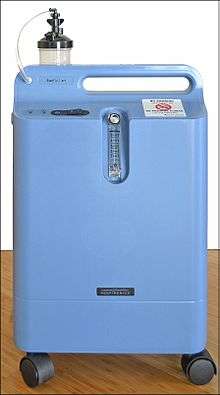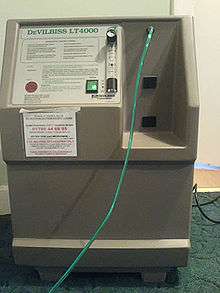Oxygen concentrator
An oxygen concentrator is a device that concentrates the oxygen from a gas supply (typically ambient air) by selectively removing nitrogen to supply an oxygen-enriched product gas stream.
Two methods in common use are pressure swing adsorption and membrane gas separation.
History
Home medical oxygen concentrators were invented in the early 1970s, with the manufacturing output of these devices increasing in the late 1970s. Union Carbide Corporation (U CC) and Bendix Corporation were both early manufacturers. Prior to that era, home medical oxygen therapy required the use of heavy high pressure oxygen cylinders or small cryogenic liquid oxygen systems. Both of these delivery systems required frequent home visits by suppliers to replenish oxygen supplies. In the United States Medicare switched from fee-for-service payment to a flat monthly rate for home oxygen therapy in the mid-1980s, causing the durable medical equipment (DME) industry to rapidly embrace concentrators as a way to control costs. This reimbursement change dramatically decreased the number of primary high pressure and liquid oxygen delivery systems in use in homes in the United States at that time. Oxygen concentrators became the preferred and most common means of delivering home oxygen. The number of manufacturers entering the oxygen concentrator market increased exponentially as a result of this change. Union Carbide Corporation (U CC) invented the molecular sieve in the 1950s which made these devices possible. U CC also invented the first cryogenic liquid home medical oxygen systems in the 1960s.
How oxygen concentrators work
Oxygen concentrators typically use pressure swing adsorption (PSA) technology and are used very widely for oxygen provision in healthcare applications, especially where liquid or pressurized oxygen is too dangerous or inconvenient, such as in homes or in portable clinics. For other purposes there are also concentrators based on membrane technology.
An oxygen concentrator takes in air and removes nitrogen from it, leaving an oxygen enriched gas for use by people requiring medical oxygen due to low oxygen levels in their blood.[1] Oxygen concentrators are also used to provide an economical source of oxygen in industrial processes, where they are also known as oxygen gas generators or oxygen generation plants. Oxygen concentrators utilize a molecular sieve to adsorb gases and operate on the principle of rapid pressure swing adsorption of atmospheric nitrogen onto zeolite minerals and then venting the nitrogen. This type of adsorption system is therefore functionally a nitrogen scrubber leaving the other atmospheric gases to pass through. This leaves oxygen as the primary gas remaining. PSA technology is a reliable and economical technique for small to mid-scale oxygen generation, with cryogenic separation more suitable at higher volumes and external delivery generally more suitable for small volumes.[2]
At high pressure, the porous zeolite adsorbs large quantities of nitrogen, due to its large surface area and chemical character. After the oxygen and other free components are collected the pressure drops which allows nitrogen to desorb.
An oxygen concentrator has an air compressor, two cylinders filled with zeolite pellets, a pressure equalizing reservoir, and some valves and tubes. In the first half-cycle the first cylinder receives air from the compressor, which lasts about 3 seconds. During that time the pressure in the first cylinder rises from atmospheric to about 2.5 times normal atmospheric pressure (typically 20 psi/138 kPa gauge, or 2.36 atmospheres absolute) and the zeolite becomes saturated with nitrogen. As the first cylinder reaches near pure oxygen (there are small amounts of argon, CO2, water vapour, radon and other minor atmospheric components) in the first half-cycle, a valve opens and the oxygen-enriched gas flows to the pressure equalizing reservoir, which connects to the patient's oxygen hose. At the end of the first half of the cycle, there is another valve position change so that the air from the compressor is directed to the second cylinder. The pressure in the first cylinder drops as the enriched oxygen moves into the reservoir, allowing the nitrogen to be desorbed back into gas. Partway through the second half of the cycle, there is another valve position change to vent the gas in the first cylinder back into the ambient atmosphere, keeping the concentration of oxygen in the pressure equalizing reservoir from falling below about 90%. The pressure in the hose delivering oxygen from the equalizing reservoir is kept steady by a pressure reducing valve.
Older units cycled with a period of about 20 seconds, and supplied up to 5 litres per minute of 90+% oxygen. Since about 1999, units capable of supplying up to 10 lpm have been available.
Applications

Medical oxygen concentrators are used in hospitals or at home to produce oxygen for patients. PSA generators provide a cost-efficient source of oxygen. They are a safer,[3] less expensive,[4] and more convenient alternative to tanks of cryogenic oxygen or pressurised cylinders. They can be used in various industries including medical, pharmaceutical production, water treatment and glass manufacture.
PSA generators are particularly useful in remote or inaccessible parts of the world or mobile medical facilities (military hospitals, disaster facilities).[5][6]
Portable oxygen concentrators

Since the early 2000s, a number of companies have produced portable oxygen concentrators.[7] Typically, these devices produce the equivalent of one to five liters per minute of continuous oxygen flow and they use some version of pulse flow or "demand flow" to deliver oxygen only when the patient is inhaling. They can also provide pulses of oxygen either to provide higher intermittent flows or to reduce the power consumption.
Research into oxygen concentration is ongoing and modern techniques suggest that the amount of adsorbent required by a medical oxygen concentrators can be potentially "reduced by a factor of three while offering ∼10–20% higher oxygen recovery compared to a typical commercial unit."[8]
These portable concentrators typically plug into an electrical outlet and may have an internal battery or external battery pack for operation away from home and during power outages. Portable oxygen concentrators usually can be plugged into the DC outlet of a vehicle, and most of these devices are suitable for ambulatory use.
The FAA has approved the use of portable oxygen concentrators on commercial airlines.[9] However, users of these devices should check in advance as to whether a particular brand or model is permitted on a particular airline.[10] Unlike in commercial airlines, users of aircraft without cabin pressurization need oxygen concentrators which are able to deliver enough flowrate even at high altitudes, such as OXYFLY.[11]
Usually, "demand" or pulse-flow oxygen concentrators are not used by patients while they sleep. There have been problems with the oxygen concentrators not being able to detect when the sleeping patient is inhaling. Some larger portable oxygen concentrators are designed to operate in continuous-flow mode in addition to pulse-flow mode. Continuous-flow mode is considered safe for night use when coupled with a CPAP machine.
Common models retail at around $600. Leasing arrangements may be available through various medical-supply companies and/or insurance agencies.
Alternate applications
Repurposed medical oxygen concentrators or specialized industrial oxygen concentrators can be made to operate small oxyacetylene or other fuel gas cutting, welding and lampworking torches.[12]
Safety
In both clinical and emergency-care situations, oxygen concentrators have the advantage of not being as dangerous as oxygen cylinders, which can, if ruptured or leaking, greatly increase the combustion rate of a fire. As such, oxygen concentrators are particularly advantageous in military or disaster situations, where oxygen tanks may be dangerous or unfeasible.
Oxygen concentrators are considered sufficiently foolproof to be supplied to individual patients as a prescription item for use in their homes. Typically they are used as an adjunct to CPAP treatment of severe sleep apnea. There also are other medical uses for oxygen concentrators, including COPD and other respiratory diseases.
Used and refurbished units should be purchased through a reputable dealer. Temperamental units are worthless to the medical community since an individual's health frequently relies on the constant extended operation of the unit. However, such units are valuable to metal and glasswork hobbyists. Because oxygen is a "permanent gas" (cannot be liquefied at any pressure at room temperature), it is expensive to obtain in bottled form.
Industrial oxygen concentrators
Industrial processes may use much higher pressures and flows than medical units. To meet that need, another process, called vacuum swing adsorption (VSA), has been developed by Air Products. This process uses a single low pressure blower and a valve that reverses the flow through the blower so that the regeneration phase occurs under a vacuum. Generators using this process are being marketed to the aquaculture industry. Industrial oxygen concentrators are often available in a much wider range of capacities than medical concentrators.
Industrial oxygen concentrators are sometimes referred to as oxygen generators within the oxygen and ozone industries to distinguish them from medical oxygen concentrators. The distinction is used in an attempt to clarify that industrial oxygen concentrators are not medical devices approved by the Food and Drug Administration (FDA) and they are not suitable for use as bedside medical concentrators. However, applying the oxygen generator nomenclature can lead to confusion. The term, oxygen generator, is a misnomer in that the oxygen is not generated as it is with a chemical oxygen generator, but rather it is concentrated from the air.
Non-medical oxygen concentrators can be used as a feed gas to a medical oxygen system, such as the oxygen system in a hospital, though governmental approval is required, such as by the FDA, and additional filtering is generally required.
See also
- Nitrogen separation membrane
- Oxygen therapy – Use of oxygen as medical treatment
- Portable oxygen concentrator
- Membrane gas separation
Notes
- What is an Oxygen Concentrator? How does it Work?. medequip.co.in Retrieved on 5 January 2018.
- Ruthven, Douglas M.; Shamsuzzman Farooq, Kent S. Knaebel (1993). Pressure Swing Adsorption. Wiley-VCH. p. 6,304. ISBN 978-0-471-18818-6.
- Duke, T.; Wandi, F.; Jonathan, M.; Matai, S.; Kaupa, M.; Saavu, M.; Subhi, R.; Peel, D. (2008). "Improved oxygen systems for childhood pneumonia: A multihospital effectiveness study in Papua New Guinea". The Lancet. 372 (9646): 1328–1333. doi:10.1016/S0140-6736(08)61164-2. PMID 18708248.
- Friesen, R. M.; Raber, M. B.; Reimer, D. H. (1999). "Oxygen concentrators: A primary oxygen supply source". Canadian Journal of Anesthesia. 46 (12): 1185–1190. doi:10.1007/BF03015531.
- "CO2CRC Research – Storing CO2". Archived from the original on September 28, 2013.
- Shrestha, B. M.; Singh, B. B.; Gautam, M. P.; Chand, M. B. (2002). "The oxygen concentrator is a suitable alternative to oxygen cylinders in Nepal". Canadian Journal of Anesthesia. 49 (1): 8–12. doi:10.1007/BF03020412. PMID 11782322.
- "The Rise of Portable Concentrator Manufacturers". Oxygen Concentrator Ratings. Retrieved 2013-10-12.
- Rama Rao, V.; Kothare, M. V.; Sircar, S. (2014). "Novel design and performance of a medical oxygen concentrator using a rapid pressure swing adsorption concept". AIChE Journal. 60 (9): 3330–3335. doi:10.1002/aic.14518.
- "FAA Approved Portable Oxygen Concentrators". FAA. Retrieved 2012-03-09.
- "List of Airlines that allow portable oxygen machines". Inogen Oxygen. Retrieved 2014-03-26.
- "Continuous Oxygen Supply for non-pressurized Aircraft". OXYFLY. Archived from the original on 2012-06-10. Retrieved 2012-06-04.
- "Testimonials". Archived from the original on July 7, 2007. Retrieved 2013-09-18.
-solution.jpg)

